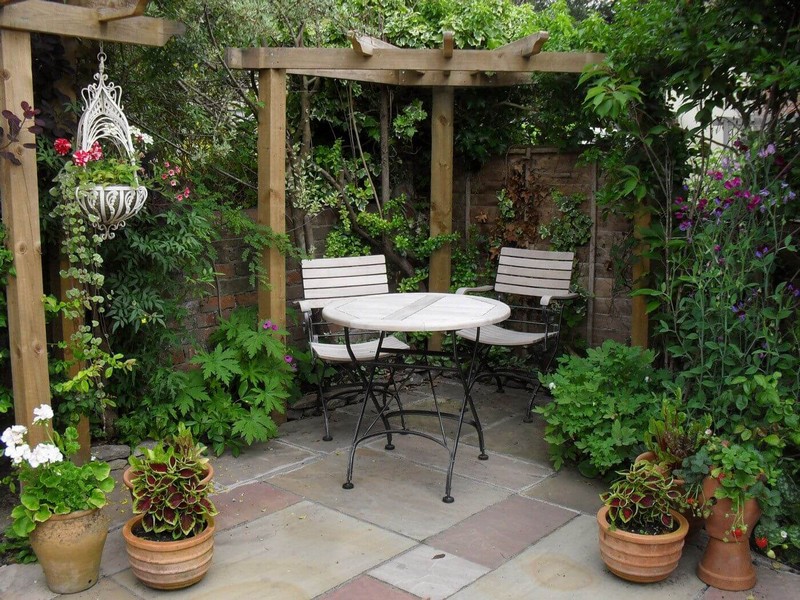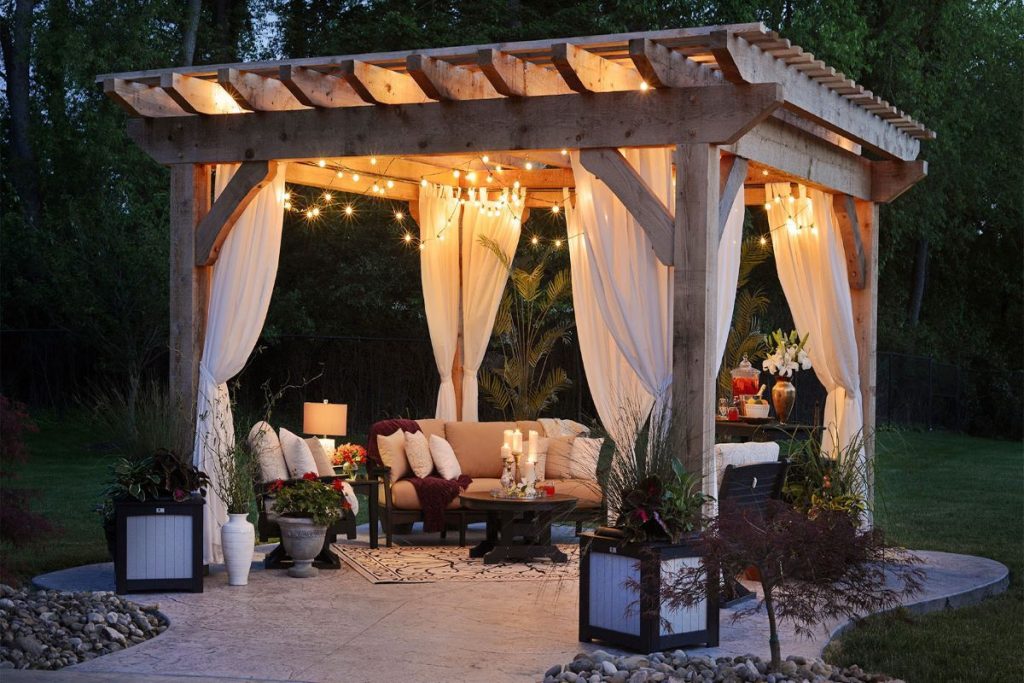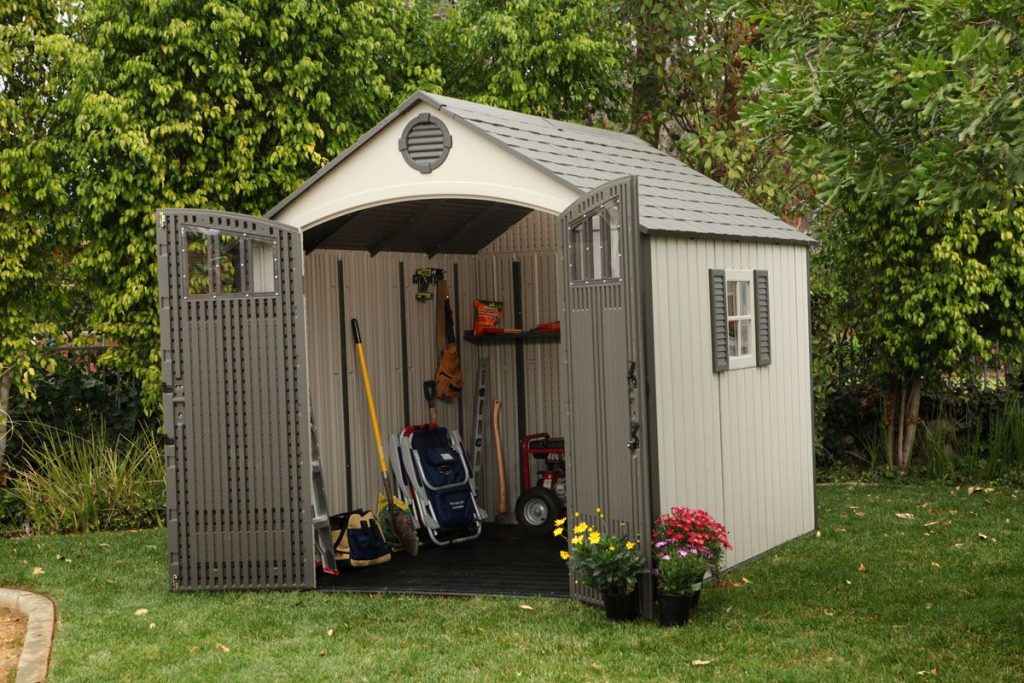Table of Contents
Building a pergola is a wonderful way to add value to your home. Primarily, a pergola is a low-cost landscaping feature that offers support for vines to create a focal point in the garden. It can also create a sheltered space for relaxing and entertaining. Pergolas range from simple, streamlined designs to more elaborate, complex structures that complement or even enhance the architectural style of your home. They are easy to tailor to meet the needs of any home or budget and take as little time as a weekend to erect.
What is a Pergola?
A pergola is a traditional feature found in gardens. Columned structures were common throughout the Mediterranean region and are a part of the Tuscan-style courtyard design. Here, simple roof trusses give a supporting frame for grapevines and overenthusiastic wisteria to ramble. These whimsical plants provide shade throughout the warmer months, only to lose their leaves in winter to allow the sunlight in when it is most welcomed. Today, the term “pergola” describes a structure with wooden legs, support beams, and roof trusses.
Why Choose a Pergola?
Pergolas are classy additions to any home and are easily tailored to blend with existing buildings. They increase the value of your property. Pergolas are also a great way to develop under-utilized space in your yard. A correctly placed pergola helps to shield windows from the intense summer heat and allows winter light in, which in turn makes the home more energy-efficient. Ultimately, a pergola is a more affordable option for home renovations.
What Type of Pergola is Best for My Home?

It depends on how you wish to use it. They are so adaptable that the sky really is the limit. Below are some points to consider when building a pergola:
The Location
Typically, a pergola stands independently in the garden. However, you can attach the structure to existing buildings. This works very well if you are searching for a way to increase your outdoor living areas.
The Purpose
The sophisticated presence of a pergola creates a point of interest in the garden. It can be a modest gesture in a traditional cottage garden, or a more regal centerpiece in a formal, more manicured setting. A pergola brings life to a troubled corner of a yard where little will grow. It also ties buildings together by extending the existing roof line. A pergola offers the ability to change or enhance the street appeal of your property too.
The Style
A traditional design can complement most homes. But the wondrous thing about pergolas is that they allow you to become a little more creative. The support legs can become features in themselves.
You can create:
- A colonial style by using turned wood
- A log cabin effect by using large logs
- A dramatic, timeless effect by using stone, brick or concrete columns Pergolas traditionally do not have a covered roof; they rely on the climbing vine to produce shade. However, there is no rule stating you can’t cover yours.
Some options include:
- Shade cloth
- Fiberglass sheeting
- Retractable shade canopies
You can finish pergolas in many ways too.
- latticework attached to side walls
- painted, or stained and varnished
- render the brick or concrete legs
Whatever the style, pergolas are a great way to create some pizzazz in your garden. They are a low-cost addition that increases the value of your property whilst offering extensions to outdoor living facilities. They can cover lawns, paved areas, and even decking. A pergola is truly a treasured addition to any backyard.
Building a Pergola for Beginners: Tips, Tricks, and Ideas for a Beautiful and Functional Outdoor Structure
Introduction
A pergola is a simple structure that can add significant value to your outdoor space. Not only does it provide shade and privacy, but it can also be an aesthetic addition to your garden. However, building a pergola can be an intimidating task, especially for beginners. This article aims to provide a detailed guide on how to build a pergola for beginners, along with some tips and tricks to make the process easier.
Building a Pergola
When it comes to building a pergola, there are several ways to go about it. One of the best ways to build a pergola is by using an easy build pergola kit. These kits come with everything you need to build a basic pergola, including pre-cut lumber, brackets, and hardware. Alternatively, you can build a DIY pergola from scratch, which requires more time and effort but allows for greater customization. Another option is to use online tools to design your own pergola and have it delivered to you as a kit.
If you’re building a pergola on a budget, there are several ways to save money. For instance, you can use pressure-treated lumber instead of cedar or redwood, which can significantly reduce the cost. You can also opt for a smaller pergola, which requires less material and labor. Additionally, you can choose a simple design that doesn’t require many fancy cuts or intricate details.
Adding Shade to a Pergola
Adding shade to a pergola is a crucial step, especially if you live in a hot and sunny climate. One of the easiest ways to create shade is by adding a pergola canopy. You can buy pre-made canopies online or make your own using fabric and hardware. If you want a more versatile solution, you can make a retractable pergola canopy, which can be pulled back when you want more sunlight.
Another way to add shade to your pergola is by planting vines or climbing plants around it. These plants can create a natural canopy that provides shade and privacy. However, keep in mind that these plants require maintenance and can attract pests.
If you want a more permanent solution, you can build a pergola with a roof. This type of pergola provides full shade and protection from the rain, making it ideal for outdoor dining or entertainment. However, building a roofed pergola requires more planning and construction skills.
Making a Garden Arbor
A garden arbor is a simple structure that can add a touch of elegance to your garden. It’s typically made of wood or metal and features a trellis or lattice design. Making a garden arbor is a relatively easy DIY project that can be completed on a weekend. You’ll need some basic carpentry skills, along with a few tools and materials.
To make a garden arbor, start by selecting the right location and size. Choose a spot that gets plenty of sunlight and has enough space for the arbor. Then, determine the height and width of the arbor, taking into account the plants you want to grow on it.
Next, gather the materials you’ll need, such as pressure-treated lumber, screws, and hardware cloth. Cut the lumber to the desired size and shape, and assemble the arbor using screws and brackets. Finally, attach the hardware cloth to the arbor and plant your favorite climbing plants around it.
Adding More Features to a Pergola
There are several ways to enhance your pergola and make it more functional and attractive. One way to add privacy to your pergola is by installing screen panels or curtains. These panels can be made of fabric, bamboo, or other materials and provide privacy while still allowing airflow.
Another way to add shade to your pergola is by installing a bamboo gazebo. This type of gazebo is made of bamboo poles and provides a natural and rustic look to your pergola. You can also add more shade by creating a pergola cover using fabric or a shade sail. This is a cost-effective way to provide shade and protection from the sun.
If you want to add more style and character to your pergola, you can add decorative elements such as lights or hanging plants. String lights or lanterns can create a cozy and romantic ambiance while hanging plants can add color and texture to the pergola.
Building an Arbor over a Patio
If you have a patio or deck that you want to enhance, building an arbor over it is a great way to add some charm and character. A patio arbor can provide shade and privacy, as well as a focal point for outdoor gatherings.
To build an arbor over a patio, start by measuring the size of the patio and determining the desired height and width of the arbor. You can use a pre-built arbor kit or build one from scratch using pressure-treated lumber and hardware.
Attach the arbor to the patio using brackets or bolts and make sure it’s secure. Then, add a trellis or lattice panel to the top of the arbor to create a natural canopy. Finally, add some climbing plants around the arbor to create a lush and beautiful backdrop.
Tips and Tricks for Building a Pergola
Building a pergola can be a daunting task, but with the right tools and techniques, anyone can do it. Here are some tips and tricks to make the process easier:
Plan ahead: Before you start building, make sure you have a clear plan in place. This includes the size, location, and design of the pergola, as well as the materials and tools you’ll need.
Choose the right location: Make sure you choose a location that’s level, sturdy and has good drainage. Avoid areas with overhanging branches or power lines.
Use quality materials: Invest in high-quality materials that can withstand the elements and last for years. Cedar, redwood, and pressure-treated lumber are good options.
Measure twice, cut once: Take accurate measurements and double-check them before making any cuts. This can save you time and money in the long run.
Take safety precautions: Wear protective gear, such as gloves and safety glasses, and use tools properly to avoid injury.
Get help if needed: Don’t hesitate to ask for help from friends or professionals if you need it. Building a pergola can be a team effort.
Conclusion
Building a pergola can be a fun and rewarding project for beginners. With the right tools and techniques, anyone can create a beautiful and functional structure that adds value to their outdoor space. Whether you’re looking to add shade, privacy, or style to your garden or patio, a pergola is a great way to do it. With the tips and tricks provided in this article, you’ll be on your way to building your very own pergola in no time.








